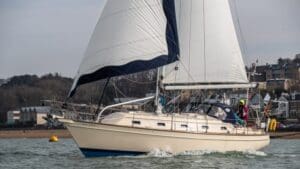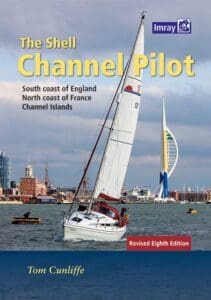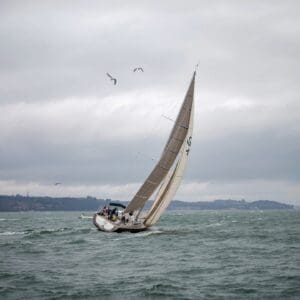Picture this: it’s 6am on a bright Saturday morning in July, you’re sipping coffee in the cockpit while the kids are still asleep below, and the Solent’s just starting to hum with sails and ferries. You’ve got the weekend ahead and a family crew eager for some adventure – but you also know what’s coming: packed marinas, rafted boats, and the odd frayed temper at the fuel dock. Here’s the good news – with a little planning, you can make a summer coastal hop not just survivable, but memorable for all the right reasons. The kind of trip where the kids come back telling their friends about crabbing on the pontoon, not “Dad yelling about fenders” as you squeeze into a berth.
This is how I do it aboard Sea Mist – my floating cottage with sails – when we head out for a family weekend on the south coast.
Start with the Right Destination
For family hops, I like to think in half-day passages. With kids aboard, it’s not about maximising miles – it’s about keeping everyone fresh and happy. That usually means 10–15 NM legs in settled weather in the Solent, or 20–25 NM if we’re heading along the coast.
Here are some of my favourites:
- Hamble to Newtown Creek – 14 NM, mostly sheltered, plenty of wildlife spotting en route.
- Portsmouth to Bembridge – 12 NM, a mix of open water and sheltered approach, great for a beach afternoon.
- Lymington to Yarmouth – 5 NM, the perfect “lazy hop” with time for ice cream ashore.
By keeping the mileage short, you buy time for shore activities: crabbing lines, ice cream runs, maybe a beach BBQ if the weather plays ball.
Plan for the Traffic – and Use it to Your Advantage
Summer on the south coast means ferry wakes, race fleets, and the odd powerboat that thinks “slow speed” is optional. Don’t fight it – plan around it.I always have the ferry timetables for Portsmouth, Lymington, and Yarmouth in my passage notes. It’s not about avoiding them completely – it’s about timing your approaches so you’re not jockeying for position in their turning basins. Same goes for race starts: if you’re heading past Cowes on a Saturday in August, check the regatta calendar. The difference between threading through 50 spinnakers and gliding past an empty start line is about 30 minutes of planning.
Make the Boat Part of the Holiday
One of the perks of an Island Packet is the space and comfort below. The saloon’s roomy enough for a proper board game session (though the dice do sometimes escape into the bilge), and there’s enough fridge space for a weekend’s worth of treats. When the kids were younger, I used to set up a cockpit fishing station with a handline and bucket – nothing keeps them occupied like waiting for a mackerel bite. These days, they’re more likely to take the helm or help with sail trim.
Chart Note: Approaching Newtown Creek in Summer
Newtown’s a gem – but it’s busy in summer, and the entrance can be tricky on a rising tide with an onshore breeze. From the Hamble, I plan my departure so we arrive at HW Portsmouth -2 hrs, giving enough water over the bar and time to find a spot before the moorings fill. Keep an eye on the depth sounder from Gurnard Ledge buoy onwards, and make your approach on the recommended track from the NW, giving the shingle spit at Hamstead Point a wide berth. Inside, I favour anchoring rather than fighting for a visitor buoy – the IP380’s ground tackle lets me sleep easy even if the wind shifts overnight.
Keep Crew Morale High Underway
Happy crew = happy skipper. I always make sure we’ve got:
- Plenty of snacks within easy reach
- One simple hot meal prepped for each day (pasta bake or chilli in the oven works wonders)
- Warm layers – even in August, it can get chilly if you’re on the helm for an hour in a breeze
If the younger crew get restless, I hand them the binoculars and give them a “spotting list”: ferries, cruise ships, lighthouses, or a “bonus” dolphin sighting if we’re lucky.
Chris’s Top 3 Tips for Stress-Free Family Sailing
1. Keep Passages Short – Aim for arrival before mid-afternoon; tired crew make for tense moorings.
2. Have a Plan B – Know an alternate berth or anchorage if your first choice is full.
3. Involve Everyone – Give each crew member a “job” suited to their age and confidence.
Arrival: Make the End of the Day a Celebration
When we get alongside or set the hook, the first order of business is always a drink in the cockpit. For the kids, it’s hot chocolate or a fancy lemonade; for the grown-ups, something cold from the fridge. If we’re alongside, we’ll go for a wander – hunt down the best ice cream shop, stretch our legs, and let the younger crew burn off some energy. If we’re at anchor, I rig the transom ladder and we have a swim before supper.
Keep it Light, Keep it Fun
The biggest mistake I see skippers make with family crews is treating every trip like a mini-ocean passage. The summer coastal hop is about moments, not miles: the first sight of the Needles in the evening sun, the smell of bacon from the galley at anchor, the chatter in the cockpit as the tide turns. If the weather turns or the crew’s had enough, don’t be afraid to cut a passage short. Sometimes the best stories come from an unplanned night in a harbour you’d never have chosen on paper.
Final Word
Sailing the south coast in summer with family aboard is about balance – enough planning to dodge the stress points, but enough flexibility to make the most of those little moments. On Sea Mist, I’ve learned that the short hop done well beats the epic slog every time. And when the kids are still talking about the trip a week later – well, that’s when you know you’ve got it right. So next time you’re in the pub and someone says summer sailing’s too crowded, tell them this: “It’s only crowded if you go where everyone else goes, when everyone else is going. Time it right, pick your spot, and you’ll think you’ve got the coast to yourself.”
Fair Winds,
Chris


